CONFIRMATORY FACTOR ANALYSIS OF ISO-AHOLA’S MOTIVATIONAL THEORY: AN INVESTIGATION ON CHINESE TOURISTS IN THAILAND
Main Article Content
บทคัดย่อ
The purpose of this paper is to (1) perform a confirmatory factor analysis of Iso-Ahola’s motivational theoretical construct by following the work of Snepenger et al in Thailand tourism context; (2) empirically test the higher order model to assess the nature of relationship between motivation factors in relation to its various dimensions.
The methodology involved the compilation of a literature review and conduction of quantitative approach. The confirmatory factor analysis was performed by using a data of 345 Chinese tourists traveled to Thailand. The results of this study revealed the comparable results as reported by Snepenger et al. and confirmed the existence of Iso-Ahola’s motivational theory. A measurement model of Iso-Ahola’s theory showed a good model fits with the following values: χ2/df = 2.632, GFI = 0.945, AGFI = 0.910, CFI = 0.965, NFI = 0.944, RMR = 0.030, and RMSEA = 0.069. The result of this study would enable service providers a clear understanding of tourist’s motivation. It is the essential for service providers to obtain the knowledge of tourists’ behavior.
การศึกษาวิจัยในครั้งนี้มีวัตถุประสงค์เพื่อตรวจสอบความสอดคล้องของแบบจำลองโครงสร้างองค์ประกอบทฤษฎีแรงจูงใจของ Iso-Ahola โดยทำตามขั้นตอนของ Snepenger และคณะในบริบทการท่องเที่ยวของประเทศไทย วิธีการศึกษาในครั้งนี้ใช้วิธีการทบทวนวรรณกรรม และการวิจัยเชิงเชิงปริมาณเพื่อวิเคราะห์องค์ประกอบเชิงยืนยันและความสอดคล้องของแบบจำลองการวัดทฤษฎีแรงจูงใจ โดยใช้ข้อมูลจากนักท่องเที่ยวชาวจีนที่เดินทางมายังประเทศไทยจำนวน 345 คน ผลของการศึกษานี้แสดงให้เห็นถึงผลลัพธ์ที่สอดคล้องจากรายงานของ Snepenger et al. และยืนยันถึงทฤษฎีแรงจูงใจของ Iso-Ahola
ผลการตรวจสอบความสอดคล้องของแบบจำลองการวัดทฤษฎีแรงจูงใจของ Iso-Ahola กับข้อมูลเชิงประจักษ์พบว่า ค่าสถิติที่ไคสแควร์สัมพันธ์มีรูปแบบที่ดี (χ2/df) เท่ากับ 2.632 ค่าดัชนีวัดระดับความกลมกลืน (GFI) เท่ากับ 0.945 ค่าดัชนีวัดระดับความกลมกลืนที่ปรับแก้แล้ว AGFI เท่ากับ 0.910 ค่าดัชนีวัดระดับความสอดคล้องกลมกลืนเปรียบเทียบ (CFI) เท่ากับ 0.965 ค่าดัชนีวัดระดับความกลมกลืน (NFI) เท่ากับ 0.944 ค่าดัชนีรากกำลังสองเฉลี่ยของค่าความคลาดเคลื่อน (RMR) เท่ากับ 0.030 และค่าดัชนีรากของค่าเฉลี่ยกำลังสองของค่าความคลาดเคลื่อน (RMSEA) เท่ากับ 0.069 แสดงว่าแบบจำลองโครงสร้างแรงจูงใจของ Iso-Ahola มีความสอดคล้องกับข้อมูลเชิงประจักษ์ ผลจากการศึกษาครั้งนี้จะทำให้ผู้ให้บริการมีความเข้าใจถึงมิติด้านแรงจูงใจของนักท่องเที่ยวที่ส่งผลต่อพฤติกรรมของนักท่องเที่ยวเป็นอย่างดี
Article Details
“ข้าพเจ้าและผู้เขียนร่วม (ถ้ามี) ขอรับรองว่า บทความที่เสนอมานี้ยังไม่เคยได้รับการตีพิมพ์และไม่ได้อยู่ระหว่างกระบวนการพิจารณาลงตีพิมพ์ในวารสารหรือแหล่งเผยแพร่อื่นใด ข้าพเจ้าและผู้เขียนร่วมยอมรับหลักเกณฑ์การพิจารณาต้นฉบับ ทั้งยินยอมให้กองบรรณาธิการมีสิทธิ์พิจารณาและตรวจแก้ต้นฉบับได้ตามที่เห็นสมควร พร้อมนี้ขอมอบลิขสิทธิ์บทความที่ได้รับการตีพิมพ์ให้แก่สถาบันการจัดการปัญญาภิวัฒน์หากมีการฟ้องร้องเรื่องการละเมิดลิขสิทธิ์เกี่ยวกับภาพ กราฟ ข้อความส่วนใดส่วนหนึ่งและ/หรือข้อคิดเห็นที่ปรากฏในบทความข้าพเจ้าและผู้เขียนร่วมยินยอมรับผิดชอบแต่เพียงฝ่ายเดียว”
เอกสารอ้างอิง
Biswas, M. (2008). Confirmatory Factor Analysis of Iso Ahola’s Motivational Theory An Appilicaiton of Structural Equation Modeling. Conference on Tourism in India - Challenges Ahead (pp. 177-188). Kozhikode: Indian Institute of Management Kozhikode.
Crompton, J. L. (1979). Motivations for Pleasure Vacation. Annals of Tourism Research, 24(4), 425-439.
Dann, G. (1977). Anomie, Ego-Enhancement and Tourism. Annals of Tourism Research, 4, 184-194.
Dann, G. (1981). Tourism Motivation: Appraisals. Annals of Tourism Research, 8(2), 189-219.
DeVellis, R. F. (2012). Scale Development Theory and Applications. Thousand Oaks, CA: SAGE Publication.
Dunn Rose, E. L. & Iso-Ahola, S. E. (1991). Sightseeing Tourist’s Motivation and Satisfaction. Annals of Tourism Research, 18(2), 226-237.
Fodness, D. (1994). Measuring Tourism Motivation. Annals of Tourism Research, 21(3), 555-581.
Hair, J. F., Black, W. C., Babin, B. J. & Anderson, R. E. (2009). Multivariate Date Analysis. Upper Saddle River, NJ: Prentice Hall.
Hsu, C. H. & Huang, S. S. (2008). Travel motivation: A critical review of the concept’s development.Oxfordshire: CABI.
Iso-Ahola, S. E. (1980). The Social Psychology of Leisure and Recreation. Iowa: William C Brown Pub.
Iso-Ahola, S. E. (1982). Toward a Social Psychology of Recreational Theory of Tourism Motivation: A Rejoinder. Annals of Tourism Research, 9(2), 256-262.
Iso-Ahola, S. E. (1984). Social Psychological Foundations of Leisure and Resultant Implications for Leisure Counseling. In E. T. Dowd. Leisure Counseling: Concepts and Applications. (pp. 97-125). Springfield, IL: Charles C. Thomas.
Kline, R. B. (2015). Principles and Practice of Structural Equation Modeling (4th ed.). NY: Guildford Press.
Lee, T. H. (2009). A Structural Model to Examine How Destination Image, Attitude, and Motivation Affect the Future Behavior of Tourists. Leisure Sciences, 31, 215-236.
Meng, F., Tepanon, Y. & Uysal, M. (2008). Measuring Tourist Satisfaction by Attribute and Motivation: The Case of a Nature-Based Resort. Journal of Vacation Marketing, 14(1), 41-56.
Michael, N., Wien, C. & Reisinger, Y. (2017). Push and Pull Escape Travel Montivations of Emirati Nationals to Austria. Journal of Culture, Tourism and Hospitality Research, 11(3), 274-296.
Ministry of Tourism and Sports. (2016). Tourist Statistics of Year 2016. Retrieved August 1, 2017, from https://newdot2.samartmultimedia.com/home/listcontent/11/222/91
Mohammad, B. & Som, A. (2010). An analysis of push and pull travel motivations of foreign tourists to Jordan. International Journal of Business and Management, 5(12), 41.
Plog, S. C. (1991). Leisure Travel: making it a growth market.... again! New Jersey: John Wiley and Sons.
Regan, N., Carlson, J. & Rosenberger III, P. J. (2012). Factore Affecting Group - Oriented Travel Intention to Major Events. Journal of Travel & Tourism Marketing, 29(2), 185-204.
Sangpikul, A. (2008). Travel Motivations of Japanese Senior Travelers to Thailand. International Journal of Tourism Research, 10(1), 81-94.
Siri, R., Kennon, L., Josiam, B. & Spears, D. (2012). Exploring Indian Tourists’ Motivation and Perception of Bangkok. Tourismos: An International Multidisciplinary Journal of Tourism, 7(1), 61-79.
Shrestha, R. U. & Thanabordeekij, P. (2017). Factors Affecting Tourist Travel Intention to Nepal After Natural Disaster. Panyapiwat Journal, 9(2), 232-243.
Snepenger, D., King, J., Marshall, E. & Uysal, M. (2006). Modeling Iso-Ahola’s Motivation Theory in the Tourism Context. Journal of Travel Research, 45(2), 140-149.
Thairath. (2017). TAT aim to increase revenue in 2017. Retrieved July 25, 2017, from https://www.thairath.co.th/content/828186 [in Thai]
Travel China Guide. (2016). China Outbound Tourism in 2016. Retrieved July 25, 2017, from https://www.travelchinaguide.com/tourism/2016statistics/outbound.htm
You, X., O’leary, J., Morrison, A. & Hong, G. S. (2000). A cross-cultural comparison of travel push and pull factors: United Kingdom vs. Japan. International Journal of Hospitality & Tourism Administration, 1(2), 1-26.


